Title: The "Dual Reduction" Sports Program: A Comprehensive Guide
In response to the "Dual Reduction" initiative, which focuses on reducing both carbon emissions and excess body weight, a comprehensive sports program can be developed to align with these goals. This program combines environmental sustainability with physical fitness to create a holistic approach to wellbeing. Below is a detailed guide to implementing such a program:
1. Program Overview
Objective
: To promote sustainable living while improving physical health.
Target Audience
: Individuals interested in reducing their carbon footprint and enhancing their fitness levels.
Duration
: Can be implemented as a longterm lifestyle change or structured into specific periods (e.g., quarterly challenges).
2. Sporting Activities
Outdoor Activities
: Encourage activities that minimize carbon footprint, such as cycling, hiking, and outdoor yoga.
Team Sports
: Organize ecofriendly team sports like ultimate frisbee, soccer, or volleyball using reusable equipment.

Water Sports
: Include activities like kayaking, paddleboarding, or swimming in natural bodies of water.
Indoor Options
: Offer indoor activities like yoga, Pilates, or dance classes with energyefficient lighting and equipment.
3. Fitness Challenges
Step Challenges
: Set daily or weekly step goals to encourage walking or running instead of using motor vehicles.
EcoFitness Challenges
: Combine physical tasks with ecofriendly actions (e.g., picking up trash while jogging).
Virtual Competitions
: Organize virtual races or fitness competitions to engage participants regardless of location.
4. Nutritional Guidance
PlantBased Emphasis
: Promote plantbased diets to reduce carbon emissions associated with meat consumption.
Local and Seasonal Foods
: Encourage the consumption of locally sourced and seasonal foods to support sustainable agriculture.
Nutrition Workshops
: Offer workshops on sustainable eating habits, meal planning, and responsible food choices.
5. Environmental Education
Workshops and Seminars
: Conduct sessions on environmental conservation, climate change, and sustainable living practices.
Outdoor Cleanup Events
: Organize community cleanups to raise awareness about waste reduction and environmental stewardship.
Partnerships
: Collaborate with environmental organizations or local farms to promote ecofriendly initiatives.
6. Community Engagement
Social Media Campaigns
: Use social platforms to share program updates, success stories, and ecofriendly tips.
Community Events
: Host events like ecofairs, farmers' markets, or green living expos to engage the community.
Volunteer Opportunities
: Provide opportunities for participants to volunteer for environmental causes or community projects.
7. Monitoring and Evaluation
Progress Tracking
: Use fitness apps or wearable devices to track physical activity and environmental impact.
Feedback Mechanisms
: Gather feedback from participants through surveys or focus groups to improve program effectiveness.
Impact Assessment
: Measure the program's impact on carbon reduction, fitness levels, and overall wellbeing.
8. Incentives and Rewards
Recognition
: Acknowledge and celebrate participants' achievements through certificates, awards, or public recognition.
Incentive Programs
: Offer incentives such as discounted gym memberships, ecofriendly products, or fitness gear.
Team Prizes
: Organize competitions with teambased rewards to foster camaraderie and motivation.
9. Sustainability Partnerships
Corporate Partnerships
: Collaborate with businesses committed to sustainability for sponsorship or support.
Government Support
: Seek support from local authorities or environmental agencies for funding or promotional assistance.
School and Workplace Programs
: Extend the program to schools or workplaces to promote a culture of sustainability.
10. LongTerm Sustainability
Continued Education
: Provide ongoing education on environmental issues and fitness trends to sustain interest.
Program Evolution
: Adapt the program based on feedback, emerging trends, and evolving environmental concerns.
Community Legacy
: Establish a lasting legacy by encouraging participants to continue ecofriendly practices beyond the program.
By implementing these strategies within the "Dual Reduction" sports program, individuals can actively contribute to a healthier planet while improving their own wellbeing through physical activity and sustainable lifestyle choices.
